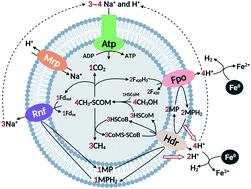当前位置:
X-MOL 学术
›
Environ. Sci.: Nano
›
论文详情
Our official English website, www.x-mol.net, welcomes your
feedback! (Note: you will need to create a separate account there.)
Nano zero-valent iron harms methanogenic archaea by interfering with energy conservation and methanogenesis
Environmental Science: Nano ( IF 5.8 ) Pub Date : 2021-10-12 , DOI: 10.1039/d1en00621e Yuanxu Song 1 , Liangfeng Duan 1 , Kaifeng Du 1 , Chao Song 1 , Shan Zhao 1 , Xianzheng Yuan 1 , Shuguang Wang 1 , Zhen Yan 1, 2
Environmental Science: Nano ( IF 5.8 ) Pub Date : 2021-10-12 , DOI: 10.1039/d1en00621e Yuanxu Song 1 , Liangfeng Duan 1 , Kaifeng Du 1 , Chao Song 1 , Shan Zhao 1 , Xianzheng Yuan 1 , Shuguang Wang 1 , Zhen Yan 1, 2
Affiliation

|
Iron-based nanoparticles (Fe-NPs), often applied for pollutant remediation, inevitably interact with various organisms either directly or indirectly. The well-acknowledged toxicological mechanisms for Fe-NPs on organisms are causing oxidative damage and disrupting membrane integrity. In this study, we focused on the interaction between Fe-NPs and methanogenic archaea, a common combination used in anaerobic digestion. We selected three forms of Fe-NPs, nanoscale zero-valent iron (nZVI), sulphide-nZVI (SnZVI) and nanoscale FeS (nFeS). We demonstrated that although all three Fe-NPs caused oxidative stress and disruption of the cell surface for Methanosarcina acetivorans, a model acetotrophic methanogen, only nZVI and SnZVI inhibited the growth and methane production. nFeS that contains Fe2+ did not show any inhibitory effect, indicating that the inhibition of growth and methane production by nZVI and SnZVI on M. acetivorans is not due to those factors. We then discovered that the growth of M. acetivorans facilitated the oxidation and dissolution of nZVI and SnZVI, generating H2 and soluble Fe2+, a process that undermined energy conservation and methanogenesis by occupying the energetic H+ gradient generated from the membrane-bound electron transport chain. Our results reveal a previously undetected harmful mechanism of nZVI on methanogenic archaea, which advances a deeper understanding of potential negative effects of applying nZVI as an engineered nanoscale material in anaerobic digestion.
中文翻译:

纳米零价铁通过干扰能量守恒和产甲烷作用危害产甲烷古菌
铁基纳米粒子 (Fe-NPs) 通常用于污染物修复,不可避免地会直接或间接地与各种生物相互作用。Fe-NPs 对生物体的公认毒理学机制正在引起氧化损伤和破坏膜完整性。在这项研究中,我们专注于 Fe-NPs 与产甲烷古菌之间的相互作用,这是一种用于厌氧消化的常见组合。我们选择了三种形式的 Fe-NP,纳米级零价铁 (nZVI)、硫化物-nZVI (SnZVI) 和纳米级 FeS (nFeS)。我们证明,尽管所有三种 Fe-NPs 都会引起Methanosarcina acetivorans(一种模型醋酸营养型产甲烷菌)的氧化应激和细胞表面的破坏,但只有 nZVI 和 SnZVI 抑制了生长和甲烷的产生。含有 Fe 2+ 的nFeS没有显示任何抑制作用,表明 nZVI 和 SnZVI 对M. acetivorans的生长和甲烷产生的抑制不是由于这些因素。然后我们发现M. acetivorans的生长促进了 nZVI 和 SnZVI 的氧化和溶解,产生了 H 2和可溶性 Fe 2+,这一过程通过占据膜结合产生的高能 H +梯度来破坏能量守恒和产甲烷作用。电子传递链。我们的结果揭示了以前未发现的 nZVI 对产甲烷古细菌的有害机制,这促进了对将 nZVI 作为工程纳米级材料应用于厌氧消化的潜在负面影响的更深入理解。
更新日期:2021-10-26
中文翻译:

纳米零价铁通过干扰能量守恒和产甲烷作用危害产甲烷古菌
铁基纳米粒子 (Fe-NPs) 通常用于污染物修复,不可避免地会直接或间接地与各种生物相互作用。Fe-NPs 对生物体的公认毒理学机制正在引起氧化损伤和破坏膜完整性。在这项研究中,我们专注于 Fe-NPs 与产甲烷古菌之间的相互作用,这是一种用于厌氧消化的常见组合。我们选择了三种形式的 Fe-NP,纳米级零价铁 (nZVI)、硫化物-nZVI (SnZVI) 和纳米级 FeS (nFeS)。我们证明,尽管所有三种 Fe-NPs 都会引起Methanosarcina acetivorans(一种模型醋酸营养型产甲烷菌)的氧化应激和细胞表面的破坏,但只有 nZVI 和 SnZVI 抑制了生长和甲烷的产生。含有 Fe 2+ 的nFeS没有显示任何抑制作用,表明 nZVI 和 SnZVI 对M. acetivorans的生长和甲烷产生的抑制不是由于这些因素。然后我们发现M. acetivorans的生长促进了 nZVI 和 SnZVI 的氧化和溶解,产生了 H 2和可溶性 Fe 2+,这一过程通过占据膜结合产生的高能 H +梯度来破坏能量守恒和产甲烷作用。电子传递链。我们的结果揭示了以前未发现的 nZVI 对产甲烷古细菌的有害机制,这促进了对将 nZVI 作为工程纳米级材料应用于厌氧消化的潜在负面影响的更深入理解。











































 京公网安备 11010802027423号
京公网安备 11010802027423号